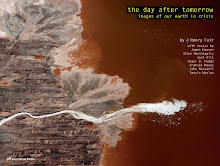Venice is the city of commerce, of conspiracy, romance, and art. It is also one of the most picturesque and expensive cities in the world. Every second year, the Bienalle brings the world's most important contemporary art together in the Giardini, on the east side of the city, for exhibit. Each nation has a pavilion which represents their most unique, talented, or possibly beloved artists to the art cognoscenti.
The weather was perfect, warm, not too humid, with a lovely breeze blowing from the ocean. Alas I had but 36 hours there, which I started by taking a walk with the lovely and dynamic Marjorie Gordon in Piazza San Marco, where the renovation of the cathedral was in its final stages. The mosaics above the doors were breathtaking in their revealed beauty. One can only imagine the mastery of the artists that created them. The detail and textures rendered were unbelievable, and to see them freshly cleaned and shining in the morning sun (we were up before the crowds) was a revelatory experience. We then proceeded to Due Mori, a famous watering hole where Marjorie insisted we have a prosecco (at 8 in the morning).
Having done all of her art browsing before my arrival, she gave me a list of “must sees” and proceeded to the beach for a day of leisure. I rousted my good friend Dietrich Petzold, the renaissance man from Berlin, and we proceeded to the Bienalle.
Our first stop was the Swiss Pavilion, which was a tremendous assortment of smashed and obsolete consumer items, many wrapped in plastic, beginning with a plethora of mobile phones, proceeding to stacks of monitors and televisions, and so on.
Anyone who knows my work would know that the message of consumption and disposal is one of my most treasured themes. My criticism with what I saw was the apparent lack of craft involved here. Perhaps it's not possible to make something of beauty out of piles of consumer detritus, but in so doing, one would create an irony that becomes much more effective than piles of garbage emitting a miasma of ozonic sickliness.
Next was the German Pavilion, which celebrated the recently deceased Christoph Schlingensief, a filmmaker whose subject matter was the the rise of fascism in Germany, another extremely resonant subject, especially as this pernicious incursion of personal liberty is ascendant worldwide, especially in the USA. But here again, my feeling was the exhibit lacked subtlety. The main room was styled to resemble a church, with macabre decoration- and of course I don't speak the language, though I am a big fan of German film. So I left dissatisfied.
Shortly along we came upon the USA pavilion, which seemed to be focused on the addiction of our culture and economy to war- again, a reverberant theme for me, but... Outside was an upended tank with a workout treadmill on one of the treads- kind of cool, but really just a demonstration of what a conceptual artist can do when someone puts a few hundred thousand dollars in the hand. Where was the craft? Inside was a weapon-bearing statue of liberty lying down in a tanning machine, and a cash machine connected to a set of organ pipes. Is this the best art my country can produce?
By this time, I was being overwhelmed by the surfeit of Swatch logos. Of course, any venture in today's world must find sponsorship, thanks to the fascistic cutting of nationally supported arts (can't cut the military due to all those enemies of the state), but the headlong indulgence of our societies to be branded amounts to a theft of personality that I resent.
One of the other brandings was by Enel, the Italian energy producer (one wonders how much mercury and carbon dioxide they are putting into our environment). The other thing that struck me was the amount of trash being produced by the whole production (here was the irony lacking in the Swiss exhibit).
Everywhere one looked was branded garbage.
Alas I had made the decision not to carry a camera, having checked them at the airport before venturing into Venice.
We then ventured to the Arsenale section of the event, at an old warehouse building where weaponry and munitions were stored, and workers housed. My impression here was much the same as before, much gimmickery and reliance on the latest techno-philia, but very little craft and meaning.
For me, a true artist has mastered her chosen field such that it becomes secondary to what the artist has to say.
At the end of the Arsenale was a refreshing exception: a film titled "The Clock," by Christian Marclay, in which he had edited together segments of many films which followed the progression of real time, showing a watch here or clock there, in some the mention of a specific time: fantastic. Impossible to imagine the amount of research and editing involved. I did not watch but bit of it, assuming I would go back later and see the whole.
The other priority on Marjorie's list (that I had time to see) was the Palazzo Grassi, which contained a group exhibit of renowned living artists. What a relief, to see this collection of thoughtful, well-executed pieces. The highlight for me was Zhang Huan, the Chinese artist who does giant portraits using incense ash from Chinese temples. Words don't describe. This is art. Beautiful, sublime, masterful. This man will hang next to history's great artists through time.
06 September 2011
Subscribe to:
Posts (Atom)





